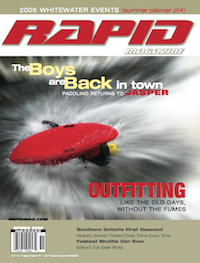As long as humans have held whitewater paddles in their hands, they’ve asked the question, “At what angle should I cross an eddy line?” Some have said 45 degrees is the best angle, others argue an approach of 90 degrees is the only way to carve smoothly into an eddy pool. The controversy has spanned several generations of paddlers, yet remains unresolved. Until now.
The solution to this mystery lies in looking closely at the eddy line itself. When you do, you’ll see that the eddy line is not really a line at all. It is actually more like a wedge pointing upstream.
In the photograph, the widening area between line A and B is what we commonly refer to as the eddy line. This eddy line, or wedge, is an area of chaotic water made up of boils and vortices. The upstream end of this wedge, often immediately downstream of a rock, marks the origin of lines A and B. Line A is the current side of the increasingly wide eddy line and line B is the eddy side.
So, how do you decide on an angle to cross the eddy line when it is actually made up of two diverging lines? To answer this, it’s best to work backwards from the eddy pool. At the end of an eddy turn, your canoe should be in the pool pointing upstream. Prior to this, the last point where the canoe was in contact with the eddy line was somewhere along line B. The most efficient entry into the eddy pool is a 90-degree turn off of line B. Any angle larger than 90 degrees results in an unnecessarily wide turn, and any angle less than 90 degrees means front ferrying over the eddy line, which is entirely too much work. The 90-degree crowd is nodding and saying, “I told you so!”
So what about line A? Is it really so important what angle you use to approach this initial eddy line? Anyone who has ever spun out on an eddy line knows it can be very important because of the influence the boils can have on the path of a canoe. As soon as the bow of your canoe touches these boils it will want to turn and face upstream. The risk is that the canoe will face upstream before it makes it to the eddy pool.
The solution is to approach line A with an angle sharp enough to cut a path across the boils so that you can still cross line B at the magic 90 degrees. Since lines A and B diverge, your approach angle will depend on how far you are from the top of the eddy. If you are very close to the top of the eddy (where the lines are close together) you can approach line A at close to 90 degrees. If you are at the bottom of the eddy (where the two lines making up the wedge are further apart) then you should approach the eddy at an angle of 45 degrees. The 45-degree folks are smiling in satisfaction.
So, the whole angle debate boils down to how high or low you hit the eddy. Choosing an approach angle depends on which part of the eddy line you are aiming for. Look carefully at the eddy line and identify both the current side and eddy side of the wedge, break out a protractor and carve a perfect arc into the pool. Mystery solved.
Andrew Westwood is a frequent contributor to Rapid. He’s an open canoe instructor at the Madawaska Kanu Centre and member of Team Esquif.



